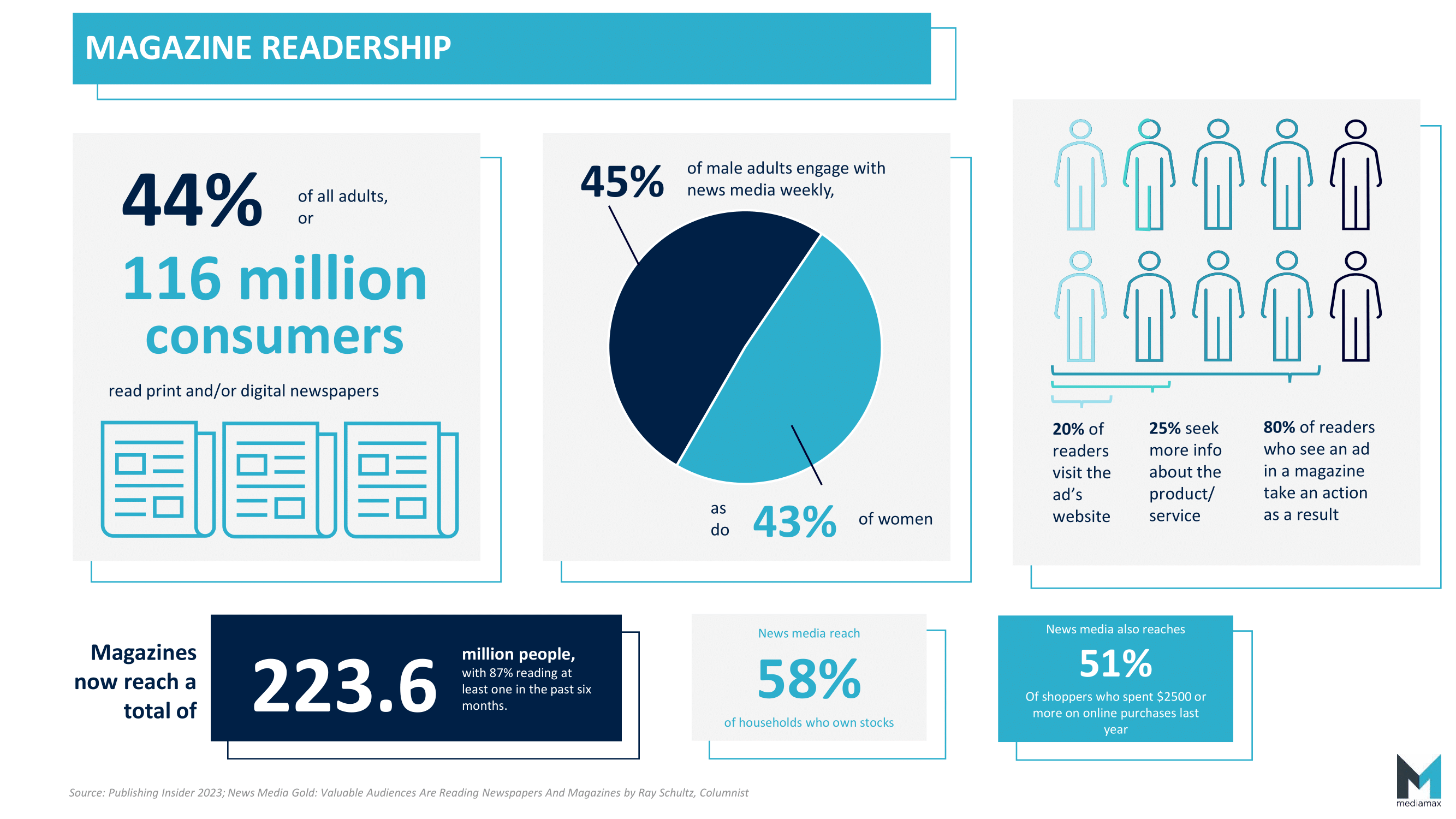Statistics Show People Still Read Magazines and Newspapers
Recent studies reveal surprising statistics: 44% of adults, equating to 116 million consumers, still engage with print or digital newspapers.
The reach of magazines is even more impressive, with a vast audience of 223.6 million people. An impressive 87% of individuals report reading at least one magazine in the past six months.
The Value of Print to Advertisers

Print media’s audience is not just large but valuable. Readers of newspapers and magazines typically have a median household income that exceeds the national average by $8,000, making them a particularly attractive audience for advertisers.
This financial advantage implies a greater disposable income and a likelihood of purchasing power, two very crucial factors for marketing strategies. Moreover, print media significantly reach households with higher-end consumption habits, such as owning hybrid/electric cars and making substantial online purchases.
A striking 80% of magazine readers report taking some form of action after viewing an advertisement.
This high engagement rate is broken down even further: 25% of these readers actively seek more information about the advertised product or service, while 20% take the significant step of visiting the advertiser’s website. Such statistics highlight the direct impact and effectiveness of magazine advertising.
Print Media’s Role in Informing Diverse Audiences
Changing Perceptions Among Younger Generations
While print media has traditionally been associated with older audiences, recent trends indicate a significant shift.
Millennials and Gen Z are turning towards print media for various reasons, including a desire for credible, well-researched content in an era of digital misinformation. The tactile experience of print, combined with a sense of nostalgia and a break from screen fatigue, contributes to its appeal among these younger demographics.
Print Media as a Cultural Connector
For Black, Hispanic, and LGBT communities, print media often serves as a cultural connector. Magazines and newspapers tailored to these groups provide a sense of community and identity. They offer a platform for voices and stories that may be underrepresented or overlooked in mainstream digital media.
This representation not only boosts readership within these communities but also fosters a greater understanding and appreciation of diverse cultures and perspectives among the broader audience.
The Role of Niche Publications
The rise of niche publications has played a crucial role in engaging diverse audiences. These publications cater to specific interests, identities, and cultural backgrounds, making print media more relevant and personalized.
From magazines focusing on LGBT issues to those celebrating Hispanic heritage, these niche publications have carved out a unique space in the print media landscape, attracting readers who seek content that resonates with their personal experiences and viewpoints.
Trust in Traditional Media
In the current media landscape, characterized by the rapid spread of misinformation, traditional print media such as newspapers and magazines have retained a high level of trust among readers. This stands in stark contrast to the often scrutinized credibility of online and social media platforms.
Readers consistently turn to print for reliable, in-depth information on critical areas such as healthcare, automotive, finance, and food. This preference stems not just from the accuracy of print media but also from its depth and quality. Perhaps an understated part of why it’s so trusted lies in its straightforward approach to informing.
Information in newspapers and magazines is typically perceived as more thoroughly researched and vetted, offering readers a sense of reliability that is increasingly valuable in an age of information overload. This trust not only emphasizes the role of print in providing reliable information but also highlights its irreplaceable value in an increasingly digital-centric world.
The Social Influence of Print Readers
Readers of print media are not merely passive consumers but active influencers within their communities. Their informed perspectives, gained through engagement with print media, often play a crucial role in shaping the opinions and purchase decisions of those around them.
This influence extends beyond personal interactions, as print readers are frequently seen as credible sources of information and advice, thereby amplifying the impact of print media through community influence.
The Diverse Content of News and Magazine Media
The breadth of content covered by news and magazine media is expansive, encompassing topics from sports and politics to lifestyle and culture.
This range is highlighted by Danielle Coffey, president & CEO of the News/Media Alliance, who notes the brand-safe environment provided by print media.
Such a wide array of content ensures that advertisers can place their messages in a context that is both trusted and relevant, appealing to a diverse readership with varying interests and concerns.
This diversity in content caters to a broad audience and adds to the credibility and appeal of print media as a whole.
Conclusion
The resilience of newspapers and magazines in the digital age is not just about survival; it’s about their continued importance and influence. Magazines and newspapers are important because of their ability to reach diverse and affluent audiences, maintain trust, and offer in-depth analysis. Print media still matters greatly in our society.
As we move further into the digital era, the role of print media cannot be underestimated. Their unique blend of trust, depth, and audience engagement continues to make them a vital component of our information landscape.
This persistent relevance highlights the importance of newspapers and magazines, affirming their role as fundamental elements in the realms of media and advertising.
